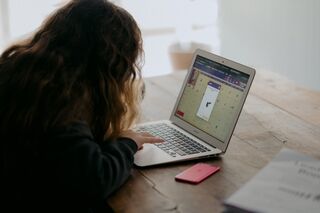Education
The Truth About Remote Schooling
It’s clear that we are nowhere near ready.
Posted July 15, 2020 Reviewed by Gary Drevitch
Has anyone had a conversation this summer without moaning and groaning about kids being home? Everywhere I look, I see articles, posts, and rants about online schooling. It feels like the anxiety has rolled in and enveloped us all. For now, we seem resigned to it. Not that we like it. And we definitely like griping about it. But what’s looming is even more befuddling: the 2020-21 school year. As many of us learned this week, schools all over the country will not open campuses to start the year. Our kids are going to keep Zooming. And Zooming. And Zooming.
So what’s the truth about remote schooling? It’s simple: We. Aren’t. Ready.
1. There's a baseline of effectiveness. Yes, students can learn remotely, but there are countless pieces to the puzzle. To start, there are a few key principles that are fairly well-established:
- Logistics. Research suggests that some in-person element is superior to online only.
- Intervention. Teachers need to provide individual attention to students and parents.
- Pedagogy. There is evidence that a combination of synchronous (live instruction) and asynchronous (pre-recorded/pre-prepared materials) learning produces better results than one or the other.
After that, it gets exponentially more difficult.
2. Massive resources are needed. I don't see a scenario in which large numbers of kids are back on campuses next month. In the best cases, we're looking at some combination of in-person and distance learning. That means maybe a few days a week in person and the rest online. But even schools that open are likely to have to close once a case or two appear in the community. On the upside, we’ll save a lot on back-to-school shopping.

The American Academy of Pediatrics has advocated “having students physically present in school.” But pundits and politicians have ignored the long list of measures in that same guidance setting forth the measures that must be in place for a safe physical return. They have subsequently released a statement clarifying and rejecting the politicization of their guidance. What the AAP calls for will cost big money and a lot of time that simply isn’t there.
In her New York Times column, Michelle Goldberg laments the fact that there’s no urgency to mobilize the resources it will take to open schools safely. And the resources needed are massive. Just the basics like effective personal protective equipment for faculty and staff would break a school's budget. Not to mention social distancing and upgraded technology.
3. It all depends on planning, training, and support. What we experienced in the spring was a case of situational remote learning. We were in an emergency. Schools had to proverbially stick a finger in the dike because there was no time to engineer a more permanent fix. Schools must develop more intentional remote learning. That means a lot of planning.
In Ed Week, Denisa Superville lays out 10 in-depth ways for schools to prepare for remote learning. Her premise, however, relies on schools to “develop or adapt curriculum to work in a virtual environment, and devise robust coaching and support for teachers.” That sounds great, and as a former teacher, I would love to dive in. But what she describes would take a year or more to truly succeed. It’s simply not possible in 6-8 weeks while budgets are being slashed.
4. Teachers will bear the burden. I give a lot of credit to teachers all over the country. In March, teachers were thrust online without training on a moment's notice. Why we continue to undervalue teachers is beyond me. I've heard stories of teachers voluntarily Zooming with students regularly during the summer, and even delivering projects and kind notes in-person to homes.
But now we expect teachers to care for and educate our most prized possessions using a completely different pedagogy, possibly for a semester or longer. Would you want a flight attendant to land your plane, or a nurse to perform a kidney transplant on a loved one? And yet, we are relying on teachers to entirely rework how they do their jobs. A teaching credential takes multiple years to obtain. We have just weeks to retrain and retool. Our teachers are stuck doing the best they can with what they have.
So where does that leave us?
It’s a wait-and-see game. There’s no consensus about how to do remote schooling in this context let alone how to pay for it. Consensus or not, we’re stuck with kids doing all or part of their learning at home and it's not going to be perfect. Please consider having an adult conversation without grousing about it: Trust me, it actually feels good.
Let’s hope schools and districts can somehow do the planning and execution, and that government acts on the financial urgency that will be needed to make this work. Until then, the anxiety, moaning, groaning, and griping goes on.
References
The Bronfenbrenner Center for Translational Research. (2020, April 27). What We Know About Distance Learning. Psychology Today. https://www.psychologytoday.com/us/blog/evidence-based-living/202004/wh…
American Academy of Pediatrics. (2020, June 25). COVID-19 Planning Considerations: Guidance for School Re-entry. https://services.aap.org/en/pages/2019-novel-coronavirus-covid-19-infec…
Goza, S. (2020, July 10). COVID-19 Message to AAP Members. American Academy of Pediatrics (AAP). https://www.nfaap.org/sso/sso.aspx?action=gettoken&nfredirect=https://s…
Goldberg, M. (2020, June 29). Remote School Is a Nightmare. Few in Power Care. The New York Times. https://www.nytimes.com/2020/06/29/opinion/coronavirus-school-reopening…
Superville, D. R. (2020, June 30). The All-Remote Schedule: No Risk to Health, High Risk to Learning. Education Week. https://www.edweek.org/ew/articles/2020/06/25/the-all-remote-schedule-n…




